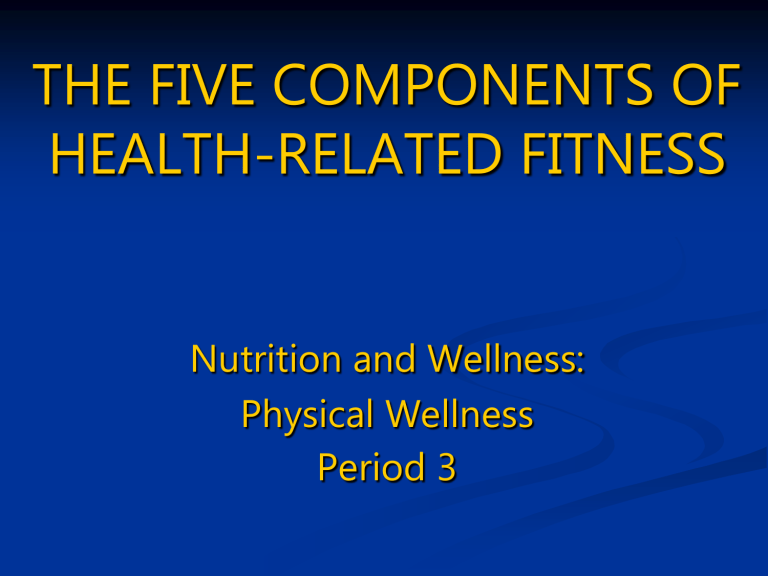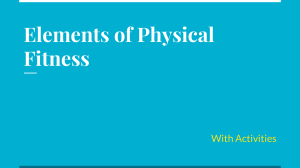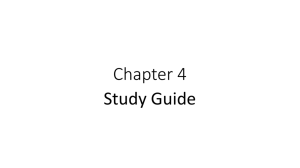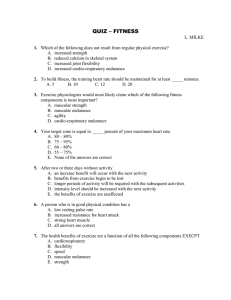
THE FIVE COMPONENTS OF HEALTH-RELATED FITNESS Nutrition and Wellness: Physical Wellness Period 3 MUSCULAR STRENGTH The ability of a muscle or muscle group to exert a maximum force against a resistance ONE TIME through the full range of motion. Range of motion (ROM) is the degrees through which a joint can move. MUSCULAR ENDURANCE The ability of a muscle or muscle group to exert a sub-maximal force REPEATEDLY over a period of time. MUSCULAR CONTRACTIONS Isotonic (meaning same tension) Isometric (meaning same distance or not moving) Isokinetic (meaning same speed) MUSCULAR CONTRACTIONS Isotonic contractions -cause the muscle to change length as it contracts and causes movement of a body part. There are two types of Isotonic contraction Concentric contractions cause the muscle to shorten as it contracts Eccentric contractions opposite of concentric and occur when the muscle lengthens as it contracts MUSCULAR CONTRACTIONS Isometric contractions generate force without changing the length of the muscle opposing force Isokinetic contractions - the muscle changes length during the contraction and produce movements of a constant speed. To measure this a special piece of equipment known as an Isokinetic Dynamometer is required CARDIOVASCULAR ENDURANCE The ability of the heart, lungs and blood vessels to deliver oxygen to your body tissues to perform moderate to high intensity exercise for PROLONGED PERIODS keeping your heart rate in the heart rate target zone Aerobic vs. Anaerobic Aerobic – Aero is Greek prefix for “air” Refers to presence of oxygen Activities that increase your heart rate for an extended period. Works the cardiovascular and respiratory systems Also called cardiovascular exercise Anaerobic Refers to the absence of oxygen high intensity exercise happens in short bursts, often at maximum level of exertion. HEART RATES Heart Rates Resting Heart Rate (RHR) is your heart rate when you are at rest, that is lying down but awake, and not having recently exerted yourself. Typically between 60-80 bpm. Maximum Heart Rate (MHR) is the number of beats per minute of the heart when working at its maximum Calculated as 220 – age = MHR Target Heart Rate Zone (THR) is an age specific heart rate range to be maintained during aerobic exercise to receive physical benefits Pulse Check Radial Pulse Place the tips of the middle and index fingers at the base of the thumb. Press down lightly Carotid Pulse Place the tips of the middle and index fingers gently just to side of the throat on the side of the neck You may take your pulse for six seconds and then add a zero to get the Heart Rate for one minute (6x10 = 60 seconds). Or for 10 seconds and multiply by 6 Or for 15 seconds and multiply by 4 TARGET HEART RATE ZONE Taking your pulse during physical activity allows you to measure how hard you are exercising. You should exercise to stay within your target heart rate zone. Basic calculation: 220 – age = _____ x 70% to 85% Maximum heart rate for a 16 year old is 204 and the target heart rate zone would be 143-173 beats per minute. LEVELS OF INTENSITY FLEXIBILITY Is the ability to move a joint through its complete range of motion (ROM). Types of Stretching: • Static stretching is slow and constant with the end position held for 10-30 seconds. • Dynamic stretching uses momentum and active muscular effort are used to stretch and the end position is not held BODY COMPOSITION Is the amount of lean body mass (bone, muscle, organs and body fluids) compared with the amount of body fat. ADULT MALE Fitness 14%-17% ADULT FEMALE 21%-24% Some ways to measure body fat: • Hydrostatic weighting • DEXA – Dual-Energy X-Ray Absorptiometry) • Bioelectrical Impedance • Skin Calipers BMI = Body Mass Index It is an indirect measure of body composition based on height and weight. SOMATOTYPES • • • • • Somatotype – inherited body type based on skeletal frame and body composition Endomorph pear shaped body rounded head wide hips and shoulders wider front to back rather than side to side. Accumulation of fat on body, upper arms and thighs • • • • • • • Mesomorph wedge shaped body cubical head wide broad shoulders muscled arms and legs narrow hips narrow from front to back rather than side to side. minimum amount of fat • • • • • • Ectomorph high forehead receding chin narrow shoulders and hips narrow chest and abdomen thin arms and legs lean muscle and fat HEALTH RELATED FITNESS Health related fitness is a lifetime pursuit. It is impossible to store fitness once it is developed. To develop fitness you should work on ALL 5 COMPONENTS: Muscle strength Muscle endurance Cardiovascular endurance Flexibility Body composition TRAINING PRINCIPLES Principle of Overload - providing a greater stress, or load, on the body than it is normally accustomed to in order to increase fitness. The FITT Principle describes how to safely apply the principles of overload, change one or more of the following variables: Frequency – how often you work Intensity – how hard you work Time – how long you work Type – type of exercise PHYSICAL ACTIVITY RECOMMENDATIONS CDC recommends the following amounts of physical activity for adolescences Frequency – daily Intensity – moderate to high Time – 60 minutes Type – cardiovascular endurance, muscular strength and bone strength SKILL RELATED COMPONENTS OF FITNESS SKILL VS. HEALTH REALTED COMPONENTS OF FITNESS HEALTH- SKILL- RELATED COMPONENTS skills that enable one to become and stay physically healthy. associated with disease prevention and functional health. RELATED COMPONENTS skills that will enhance one’s performance also called performance fitness. the AGILITY ability to change and control the direction and position of the body while maintaining a constant, rapid motion. BALANCE the ability to control or stabilize the body when standing still or moving. COORDINATION ability to use the senses together with body parts during movement. POWER the ability to perform with strength at a rapid pace. REACTION TIME the amount of time it takes to start a movement once your senses signal the need to move SPEED the ability to cover a distance in a short amount of time. BENEFITS OF EXERCISE: STRENGTHENS HEART AND LUNGS ENHANCES FEELING OF WELL-BEING STRENGTHENS MUSCLES IMPROVES AND BONES APPEARANCE PREVENTS INJURY REDUCES STRESS AND TENSION FITT Principle “To gain health benefits in all 5 components of fitness….. F = Frequency ….how often should I work out?” I = Intensity ….how much effort should I put in?” T = Time ….how long should my workout be?” T = Type …what type of exercises should I do?” muscle strength and endurance cardiovascular endurance flexibility FREQUENCY 2 – 3 days per week 5 – 6 days per week 3 or more times/week INTENSITY moderate weight TIME 3-4 sets, 6-15 reps. heart rate in to the point target zone of mild discomfort 20 – 60 10 – 30 minutes seconds TYPE major muscle groups major muscles groups major muscle groups How does the FITT principle apply to body composition? Body composition results largely from physical activity levels in the other components: Cardiovascular exercise expends calories. Muscle strength and endurance activities expend calories and build muscle (MUSCLE BURNS CALORIES FASTER THAN FAT!) Flexibility exercises allow the body to better tolerate the other exercises. DON’T FORGET ABOUT PROPER NUTRITION!!!! TRAINING PRINCIPLES: OVERLOAD – you must apply stress beyond what your body is accustomed to PROGRESSION – the overload must continue after the body adapts to the previous stress SPECIFICITY - to obtain a particular goal you must train those muscles with a specific method



